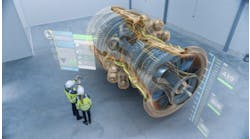Manufacturing facilities are complex environments. Workers navigate demanding physical workloads amidst heavy machinery, requiring them to have a unique blend of skill and safety awareness. Even a small mistake can have serious consequences, causing damage and impacting the company's finances and operations.
The U.S. Bureau of Labor Statistics released data late last year showing that in 2019 alone, the manufacturing industry reported 846,700 injuries, which represents 15% of all nonfatal injuries and illnesses in the private industry sector. That statistic highlights the need for a substantial improvement in worker training and preparation.
See also: Protecting OT data under persistent threat from ransomware
Embracing a modern approach, enterprises are now moving beyond traditional classroom instruction and clunky manuals by utilizing virtual reality (VR) simulation. This innovative technology is transforming how trainees engage with and retain crucial knowledge.
VR training has begun shifting the landscape of learning within manufacturing. Cost and complexity concerns, that left traditional training systems in place, have been overcome. Implementation of VR training is much easier than imagined and return on investment (in terms of quality training and resources saved) is realized in weeks and months. VR technology is solving training challenges for leaders across the industry.
Through the adoption of VR technology, training effectiveness is greatly enhanced, ensuring uninterrupted operations of critical equipment. Real-world scenarios can now be replicated in virtual environments, ensuring a seamless learning experience without production delays.
See also: What does ‘people-centric’ mean as machines get smarter?
This allows companies to achieve concurrent training and business operations, fostering growth without incurring additional costs. In a competitive marketplace, VR empowers manufacturers to safely maximize efficiency and accuracy—a powerful tool for achieving bottom-line success.
Unlocking efficiency on the factory floor
VR empowers employees to develop task proficiency and enhance focus. In fact, VR training environments improve information retention by 80%, ultimately leading to reduced production costs, increased output, and a sharper competitive edge.
See also: Navigating red-alert security challenges in manufacturing
VR technology empowers manufacturing enterprises in a variety of ways:
- Enhanced Skill Development: Field workers can improve their abilities, as VR's immersive power enables workers to conduct system troubleshooting or rehearse emergency procedures, ensuring they stay sharp for any circumstance.
- Global collaboration: Experts can initiate real-time training across the globe, optimizing training efficiency. VR training eliminates geographical barriers, enabling workforces of all sizes to train together simultaneously. This fosters consistent skill development and adherence to best practices, regardless of location.
- Immersive and interactive training: VR goes beyond traditional lectures. It's a hands-on, interactive experience that mirrors real-world scenarios. Workers build knowledge, refine skills, and gain confidence in a safe environment that encourages problem-solving and innovative thinking.
- Risk-free practice environment: VR allows workers to experiment with potentially risky situations without real-world consequences. This eliminates hazards associated with assembly or complex procedures, ensuring worker safety while maximizing learning outcomes.
Introducing a digitally immersive era
Leaders in the manufacturing industry are continuously searching for the best approaches to gain an edge amid today’s increasingly competitive landscape.
See also: Sustainability: The next step in industrial design’s evolution
By immersing workers in realistic training scenarios with VR, manufacturers can significantly enhance safety, cultivate innovation through hands-on experiences, and streamline the traditional costs associated with training.
This translates to a more skilled and confident workforce, giving companies a competitive advantage.




